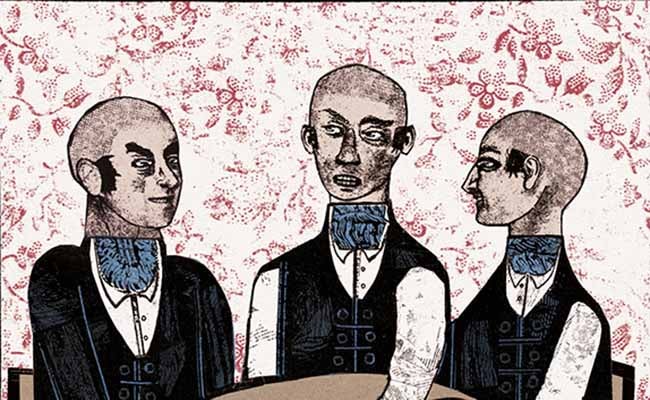'Something that makes you feel a bit jittery' | Illustrator Ben Jones discusses his work on A Clockwork Orange
When I was first asked to illustrate A Clockwork Orange for The Folio Society, after the initial feeling of joy, came a feeling of foreboding dread at the idea of creating illustrations for an already visually iconic novel – brilliantly captured in Stanley Kubrick’s 1971 film. To stop myself thinking of the film that I had not seen since I was 17 on late night TV, I purposely stopped myself from re-watching it. Instead I decided to focus on staying true to Burgess’s vision. After reading the book, I studied Burgess’s written and filmed interviews where he talked about the text. I then began to create a visual sense of the world within his book. I decided to focus on the unique language he created – Nadsat.
I liked the idea of using the alchemy of two forms of slang from Britain and Russia to form a new language for the teenage characters in the book. I felt that collage was a good method to convey this, as collage is the process of bringing disparate elements together to form something new.
[caption id="attachment_2027" align="aligncenter" width="400"] Scan of Ben's original black and white collage illustration. © Ben Jones 2014[/caption]
[caption id="attachment_2028" align="aligncenter" width="400"]
Scan of Ben's original black and white collage illustration. © Ben Jones 2014[/caption]
[caption id="attachment_2028" align="aligncenter" width="400"] 'The Mansion ... Where this very starry ptitsa lives with her cats and all these very starry valuable veshches' © Ben Jones 2014[/caption]
I was influenced by Max Ernst’s collage novel, Une Semaine de Bonté. This helped me form an idea of how I wanted to convey the ideas in the book. I also drew inspiration from Eastern European illustration and graphic design from the 1960s. I looked at artists such as Jan Lenica, Roman Cieslewicz, Bohumil Stepan and Karel Teissig. This helped in gaining a sense of the illustrative works that were being produced under the gaze of the iron curtain. I found that a lot of the work that I was looking at from Eastern Europe had a dark undertone that I wanted the illustrations to have, so I drew influence from cautionary fairy tales. I wanted to convey a subtle, possibly something that exists outside of the frame of the illustration, something that makes you feel a bit jittery. I also found that Burgess was from Manchester, and his experiences in the city had an influence on the novel. Living and working in Manchester myself, I began to explore the streets of the city and tried to picture how a dystopian version of the city might look and feel. The combination of these elements: collage, eastern European illustration, cautionary fairy tales and the city of Manchester helped to create my vision of Burgess’s novel.
[caption id="attachment_2004" align="aligncenter" width="400"]
'The Mansion ... Where this very starry ptitsa lives with her cats and all these very starry valuable veshches' © Ben Jones 2014[/caption]
I was influenced by Max Ernst’s collage novel, Une Semaine de Bonté. This helped me form an idea of how I wanted to convey the ideas in the book. I also drew inspiration from Eastern European illustration and graphic design from the 1960s. I looked at artists such as Jan Lenica, Roman Cieslewicz, Bohumil Stepan and Karel Teissig. This helped in gaining a sense of the illustrative works that were being produced under the gaze of the iron curtain. I found that a lot of the work that I was looking at from Eastern Europe had a dark undertone that I wanted the illustrations to have, so I drew influence from cautionary fairy tales. I wanted to convey a subtle, possibly something that exists outside of the frame of the illustration, something that makes you feel a bit jittery. I also found that Burgess was from Manchester, and his experiences in the city had an influence on the novel. Living and working in Manchester myself, I began to explore the streets of the city and tried to picture how a dystopian version of the city might look and feel. The combination of these elements: collage, eastern European illustration, cautionary fairy tales and the city of Manchester helped to create my vision of Burgess’s novel.
[caption id="attachment_2004" align="aligncenter" width="400"] 'Well well well well well well well. If it isn't little Alex. Very long time no viddy, droog. How goes?' © Ben Jones 2014[/caption]
The cover illustration turned out to be the biggest challenge for me. Barry Trengove’s cover for the first edition remains one of my favourite book cover illustrations to date and the 1972 cover art by David Pelham has also become an iconic piece of graphic design, so it was hard not to think of these when designing the binding. I wanted to pay tribute to both Pelham’s cover and Stanley Kubrick’s film so I decided to add a bowler hat to the cover illustration. I feel that the film has played a big part in the novel becoming immortal so wanted to show my appreciation for it, and of course there are no bowler hats mentioned within the novel.
Explore the new Folio edition of A Clockwork Orange here.
[caption id="attachment_1985" align="aligncenter" width="300"]
'Well well well well well well well. If it isn't little Alex. Very long time no viddy, droog. How goes?' © Ben Jones 2014[/caption]
The cover illustration turned out to be the biggest challenge for me. Barry Trengove’s cover for the first edition remains one of my favourite book cover illustrations to date and the 1972 cover art by David Pelham has also become an iconic piece of graphic design, so it was hard not to think of these when designing the binding. I wanted to pay tribute to both Pelham’s cover and Stanley Kubrick’s film so I decided to add a bowler hat to the cover illustration. I feel that the film has played a big part in the novel becoming immortal so wanted to show my appreciation for it, and of course there are no bowler hats mentioned within the novel.
Explore the new Folio edition of A Clockwork Orange here.
[caption id="attachment_1985" align="aligncenter" width="300"] The 2014 Folio edition of A Clockwork Orange[/caption]
The 2014 Folio edition of A Clockwork Orange[/caption]
 Scan of Ben's original black and white collage illustration. © Ben Jones 2014[/caption]
[caption id="attachment_2028" align="aligncenter" width="400"]
Scan of Ben's original black and white collage illustration. © Ben Jones 2014[/caption]
[caption id="attachment_2028" align="aligncenter" width="400"] 'The Mansion ... Where this very starry ptitsa lives with her cats and all these very starry valuable veshches' © Ben Jones 2014[/caption]
I was influenced by Max Ernst’s collage novel, Une Semaine de Bonté. This helped me form an idea of how I wanted to convey the ideas in the book. I also drew inspiration from Eastern European illustration and graphic design from the 1960s. I looked at artists such as Jan Lenica, Roman Cieslewicz, Bohumil Stepan and Karel Teissig. This helped in gaining a sense of the illustrative works that were being produced under the gaze of the iron curtain. I found that a lot of the work that I was looking at from Eastern Europe had a dark undertone that I wanted the illustrations to have, so I drew influence from cautionary fairy tales. I wanted to convey a subtle, possibly something that exists outside of the frame of the illustration, something that makes you feel a bit jittery. I also found that Burgess was from Manchester, and his experiences in the city had an influence on the novel. Living and working in Manchester myself, I began to explore the streets of the city and tried to picture how a dystopian version of the city might look and feel. The combination of these elements: collage, eastern European illustration, cautionary fairy tales and the city of Manchester helped to create my vision of Burgess’s novel.
[caption id="attachment_2004" align="aligncenter" width="400"]
'The Mansion ... Where this very starry ptitsa lives with her cats and all these very starry valuable veshches' © Ben Jones 2014[/caption]
I was influenced by Max Ernst’s collage novel, Une Semaine de Bonté. This helped me form an idea of how I wanted to convey the ideas in the book. I also drew inspiration from Eastern European illustration and graphic design from the 1960s. I looked at artists such as Jan Lenica, Roman Cieslewicz, Bohumil Stepan and Karel Teissig. This helped in gaining a sense of the illustrative works that were being produced under the gaze of the iron curtain. I found that a lot of the work that I was looking at from Eastern Europe had a dark undertone that I wanted the illustrations to have, so I drew influence from cautionary fairy tales. I wanted to convey a subtle, possibly something that exists outside of the frame of the illustration, something that makes you feel a bit jittery. I also found that Burgess was from Manchester, and his experiences in the city had an influence on the novel. Living and working in Manchester myself, I began to explore the streets of the city and tried to picture how a dystopian version of the city might look and feel. The combination of these elements: collage, eastern European illustration, cautionary fairy tales and the city of Manchester helped to create my vision of Burgess’s novel.
[caption id="attachment_2004" align="aligncenter" width="400"] 'Well well well well well well well. If it isn't little Alex. Very long time no viddy, droog. How goes?' © Ben Jones 2014[/caption]
The cover illustration turned out to be the biggest challenge for me. Barry Trengove’s cover for the first edition remains one of my favourite book cover illustrations to date and the 1972 cover art by David Pelham has also become an iconic piece of graphic design, so it was hard not to think of these when designing the binding. I wanted to pay tribute to both Pelham’s cover and Stanley Kubrick’s film so I decided to add a bowler hat to the cover illustration. I feel that the film has played a big part in the novel becoming immortal so wanted to show my appreciation for it, and of course there are no bowler hats mentioned within the novel.
Explore the new Folio edition of A Clockwork Orange here.
[caption id="attachment_1985" align="aligncenter" width="300"]
'Well well well well well well well. If it isn't little Alex. Very long time no viddy, droog. How goes?' © Ben Jones 2014[/caption]
The cover illustration turned out to be the biggest challenge for me. Barry Trengove’s cover for the first edition remains one of my favourite book cover illustrations to date and the 1972 cover art by David Pelham has also become an iconic piece of graphic design, so it was hard not to think of these when designing the binding. I wanted to pay tribute to both Pelham’s cover and Stanley Kubrick’s film so I decided to add a bowler hat to the cover illustration. I feel that the film has played a big part in the novel becoming immortal so wanted to show my appreciation for it, and of course there are no bowler hats mentioned within the novel.
Explore the new Folio edition of A Clockwork Orange here.
[caption id="attachment_1985" align="aligncenter" width="300"] The 2014 Folio edition of A Clockwork Orange[/caption]
The 2014 Folio edition of A Clockwork Orange[/caption]


